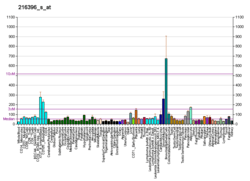EI24
| EI24 | |||||||||||||||||||||||||
|---|---|---|---|---|---|---|---|---|---|---|---|---|---|---|---|---|---|---|---|---|---|---|---|---|---|
| Identifiers | |||||||||||||||||||||||||
| Aliases | EI24, EPG4, PIG8, TP53I8, autophagy associated transmembrane protein | ||||||||||||||||||||||||
| External IDs | MGI: 108090 HomoloGene: 3588 GeneCards: EI24 | ||||||||||||||||||||||||
| |||||||||||||||||||||||||
| |||||||||||||||||||||||||
| |||||||||||||||||||||||||
| Orthologs | |||||||||||||||||||||||||
| Species | Human | Mouse | |||||||||||||||||||||||
| Entrez | |||||||||||||||||||||||||
| Ensembl | |||||||||||||||||||||||||
| UniProt | |||||||||||||||||||||||||
| RefSeq (mRNA) | |||||||||||||||||||||||||
| RefSeq (protein) | |||||||||||||||||||||||||
| Location (UCSC) | Chr 11: 125.57 – 125.58 Mb | Chr 9: 36.78 – 36.8 Mb | |||||||||||||||||||||||
| PubMed search | [3] | [4] | |||||||||||||||||||||||
| Wikidata | |||||||||||||||||||||||||
| |||||||||||||||||||||||||
Etoposide-induced protein 2.4 homolog is a protein that in humans is encoded by the EI24 gene.[5][6][7]
This gene has higher expression in p53-expressing cells than in control cells and is an immediate-early induction target of p53-mediated apoptosis. The protein encoded by this gene contains six putative transmembrane domains and may suppress cell growth by inducing apoptotic cell death through the caspase 9 and mitochondrial pathways. This gene is located on human chromosome 11q24, a region frequently altered in cancers. Alternative splicing results in two transcript variants encoding different isoforms.[7]
References
- 1 2 3 GRCh38: Ensembl release 89: ENSG00000149547 - Ensembl, May 2017
- 1 2 3 GRCm38: Ensembl release 89: ENSMUSG00000062762 - Ensembl, May 2017
- ↑ "Human PubMed Reference:".
- ↑ "Mouse PubMed Reference:".
- ↑ Gu Z, Flemington C, Chittenden T, Zambetti GP (Jan 2000). "ei24, a p53 response gene involved in growth suppression and apoptosis". Mol Cell Biol. 20 (1): 233–41. doi:10.1128/MCB.20.1.233-241.2000. PMC 85079. PMID 10594026.
- ↑ Polyak K, Xia Y, Zweier JL, Kinzler KW, Vogelstein B (Sep 1997). "A model for p53-induced apoptosis". Nature. 389 (6648): 300–5. doi:10.1038/38525. PMID 9305847.
- 1 2 "Entrez Gene: EI24 etoposide induced 2.4 mRNA".
Further reading
- Maruyama K, Sugano S (1994). "Oligo-capping: a simple method to replace the cap structure of eukaryotic mRNAs with oligoribonucleotides". Gene. 138 (1–2): 171–4. doi:10.1016/0378-1119(94)90802-8. PMID 8125298.
- Suzuki Y, Yoshitomo-Nakagawa K, Maruyama K, et al. (1997). "Construction and characterization of a full length-enriched and a 5'-end-enriched cDNA library". Gene. 200 (1–2): 149–56. doi:10.1016/S0378-1119(97)00411-3. PMID 9373149.
- Gu Z, Gilbert DJ, Valentine VA, et al. (2000). "The p53-inducible gene EI24/PIG8 localizes to human chromosome 11q23 and the proximal region of mouse chromosome 9". Cytogenet. Cell Genet. 89 (3–4): 230–3. doi:10.1159/000015620. PMID 10965130.
- Burns TF, Bernhard EJ, El-Deiry WS (2001). "Tissue specific expression of p53 target genes suggests a key role for KILLER/DR5 in p53-dependent apoptosis in vivo". Oncogene. 20 (34): 4601–12. doi:10.1038/sj.onc.1204484. PMID 11498783.
- Gentile M, Ahnström M, Schön F, Wingren S (2002). "Candidate tumour suppressor genes at 11q23-q24 in breast cancer: evidence of alterations in PIG8, a gene involved in p53-induced apoptosis". Oncogene. 20 (53): 7753–60. doi:10.1038/sj.onc.1204993. PMID 11753653.
- Strausberg RL, Feingold EA, Grouse LH, et al. (2003). "Generation and initial analysis of more than 15,000 full-length human and mouse cDNA sequences". Proc. Natl. Acad. Sci. U.S.A. 99 (26): 16899–903. doi:10.1073/pnas.242603899. PMC 139241. PMID 12477932.
- Olsen JV, Blagoev B, Gnad F, et al. (2006). "Global, in vivo, and site-specific phosphorylation dynamics in signaling networks". Cell. 127 (3): 635–48. doi:10.1016/j.cell.2006.09.026. PMID 17081983.
This article is issued from
Wikipedia.
The text is licensed under Creative Commons - Attribution - Sharealike.
Additional terms may apply for the media files.




